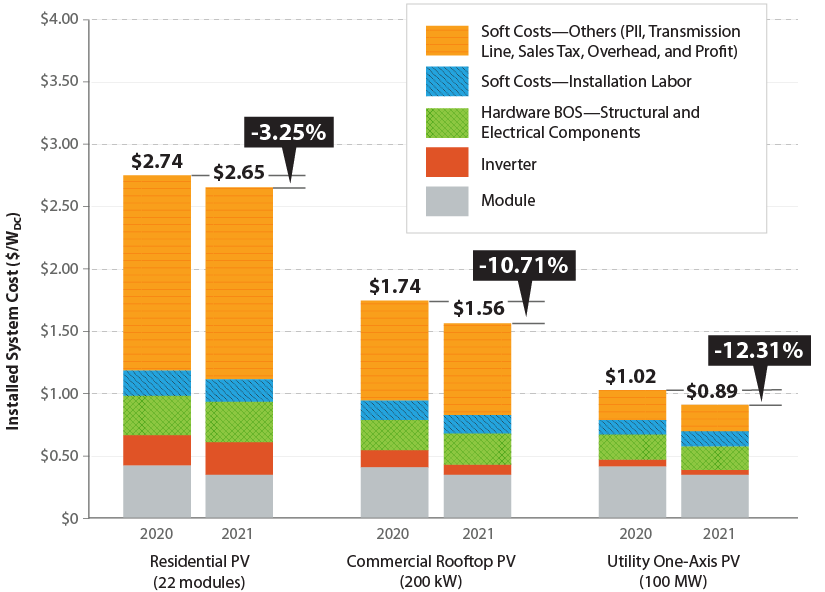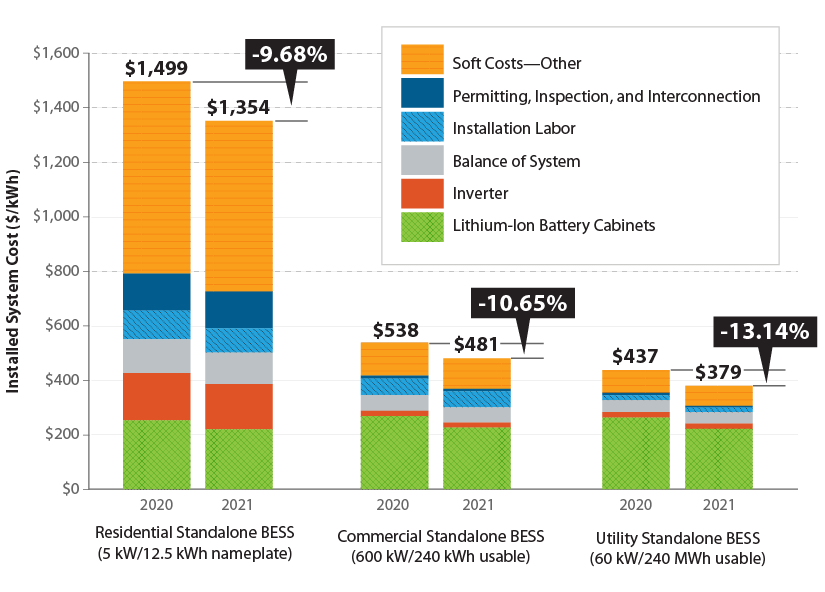The National Renewable Energy Laboratory (NREL) ]released its annual cost breakdown of installed solar photovoltaic and battery storage systems.
U.S. Solar Photovoltaic System and Energy Storage Cost Benchmark: Q1 2021 details installed costs for PV systems as of the first quarter of 2021.
The report said that costs continue to fall for residential, commercial rooftop, and utility-scale PV systems by 3%, 11%, and 12%, respectively, compared to last year.
In a change from previous years’ reports, balance of systems costs have increased or remained flat across sectors this year. However, the report said this increase in balance of systems cost was offset by a 19% reduction in module cost, causing overall costs to continue their decade-long decline.

The report’s authors used a cost modeling approach that accounts for all system and project development costs incurred during installation to model the costs for residential, commercial, and utility-scale PV systems, with and without energy storage. They also modeled typical installation techniques and business operations from an installed-cost perspective. NREL said this approach helps ensure that hardware costs reflect the actual purchase price of components as well as the sales price paid to the installer, including profits. The benchmarks assume a business environment unaffected by the novel coronavirus pandemic and represent national averages.
The major cost drivers that helped reduce the system installation costs of PV and energy storage systems in Q1 2021 were lower module cost, increased module efficiency, and lower battery pack cost, said NREL’s solar and storage techno-economic analyst, Vignesh Ramasamy.
Starting with the 2020 PV benchmark report, NREL began including PV-plus-storage and standalone energy storage costs in its annual reports. The 2021 benchmark report finds continued cost declines across residential, commercial, and industrial PV-plus-storage systems, with the greatest cost declines for utility-scale systems (up to a 12.3% reduction). Standalone storage systems also experienced cost declines.

A major component of total installed system costs is the cost of the PV modules. In a second report, Photovoltaic Module Technologies: 2020 Benchmark Costs and Technology Evolution Framework Results, NREL researchers calculated a minimum sustainable price (MSP)—the price necessary to support a sustainable business over the long term—for modules. The report calculated that price by using bottom-up manufacturing cost analysis and applying a gross margin of 15%.
The report benchmarked three established, mass-produced PV technologies as well as two technologies that NREL described s “promising” and that currently are under development or in pilot production.
Crystalline silicon (c-Si) dominates the current PV market, and its MSPs are the lowest—$0.25–$0.27/watt across the c-Si technologies analyzed. Cadmium telluride (CdTe) modules have a slightly higher MSP ($0.28/watt), and the copper indium gallium (di)selenide (CIGS) MSP takes a still bigger step up ($0.48/watt), largely as a result of higher labor, equipment, and facility costs.
 The two developing technologies the report considers are III-V and perovskite PV technologies. At $77/watt, the III-V MSP benchmark is higher than the benchmarks for established technologies, which has kept III-V PV technology in niche markets, such as space and terrestrial concentrator applications. NREL said this challenge is reflected in the III-V road map, in which several potential cost reductions still result in a long-term projection of $20/watt, some two orders of magnitude higher than the long-term MSPs of the other technologies. However, III-V modules could still be worth pursuing, the report said, because they are the highest-efficiency PV products on the market. The current highest research-cell efficiency is 47.1% for a multijunction III-V device, and even higher efficiencies are possible.
The two developing technologies the report considers are III-V and perovskite PV technologies. At $77/watt, the III-V MSP benchmark is higher than the benchmarks for established technologies, which has kept III-V PV technology in niche markets, such as space and terrestrial concentrator applications. NREL said this challenge is reflected in the III-V road map, in which several potential cost reductions still result in a long-term projection of $20/watt, some two orders of magnitude higher than the long-term MSPs of the other technologies. However, III-V modules could still be worth pursuing, the report said, because they are the highest-efficiency PV products on the market. The current highest research-cell efficiency is 47.1% for a multijunction III-V device, and even higher efficiencies are possible.
The report also offered NREL’s first techno-economic assessment of perovskite PV modules. The estimated MSP for a single-junction sheet-to-sheet perovskite module at a small production scale is $0.38/watt, with potential cost reductions projected to reduce the MSP over the long term to $0.18/watt, assuming performance can be improved without driving up costs. Perovskites can also be combined with other PV technologies in multijunction configurations. The report estimated an MSP of $0.31/watt for perovskite-on-Si tandem modules in early production based on pilot production results.
Cost reductions from economies of scale as production grows and the accumulation of manufacturing experience are also important, but they are not included in NREL’s cost-reduction road maps. Other module price drivers not captured in this analysis include global supply and demand fluctuations, domestic policies related to PV deployment and manufacturing, trade policies, and corporate strategies.
This content is protected by copyright and may not be reused. If you want to cooperate with us and would like to reuse some of our content, please contact: editors@pv-magazine.com.









Wonder how they came to 23 cent/w modules for residential jobs…most EPC’s pay at least double that, even the big ones.